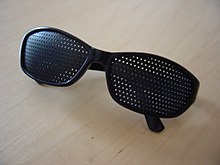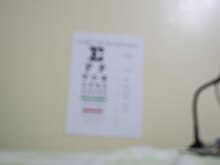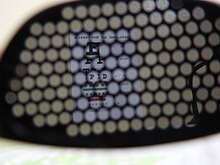Grid glasses
In the case of grid glasses (also: pinhole glasses or lattice goggles ), optically effective glasses are not used, but black plastic disks that are pierced with tiny holes in the form of a grid pattern ("grid"). It has no corrective refractive effect, but by limiting the incidence of light according to the principle of the Stenopean gap, similar to the effect of a narrow pinhole, in some cases a sharper image can result. However, this improvement in visual acuity has at best a diagnostic or experimental character and is more or less of no practical use in everyday life, regardless of the possible subjective impression of each individual.
Types of pinhole glasses
The following types of grid glasses are available:
- with full-area grid (through holes),
- with square grid (square punchings),
- with pyramidal grid (holes arranged in a pyramid shape in curved disks)
- with "bifocal" grid (different hole sizes).
Benefits and effectiveness
The manufacturers and proponents of pinhole glasses attribute the following benefits to them, which are supposed to result from their wear:
- optical refractive errors such as short - or long-sightedness are, " trained away " can be,
- the visual acuity when looking through the small holes should improve significantly,
- the external eye muscles are to be strengthened by the required saccade movements,
- there should be positive effects on eye diseases such as glaucoma or cataracts ,
- The grid glasses are particularly suitable as sunglasses for people who need full-spectrum sunglasses because they are permeable to UV radiation.
criticism
So far, no scientific proof has been provided that wearing pin glasses has a positive effect on the objective extent of ametropia , i.e. the strength of myopia or farsightedness.
When looking through the small openings, the sharpness of the image can in some cases increase. This phenomenon is based on the principle of the Stenopean gap and results from the elimination of disruptive marginal rays ( spherical aberration ). One effect is the increase in the depth of field, comparable to the effect of a pinhole on a camera, which is used in ophthalmological diagnostics . Overall, however, the temporary improvement in visual acuity achieved in this way is associated with very little practical benefit, as there is a major restriction of the field of vision , which is associated with clear deficits with regard to safe orientation in the outdoor area. Both critics as well as manufacturers and distributors therefore strictly advise against wearing pinhole glasses for activities that require fast-reacting and high-quality visual perception, e.g. B. when driving a car or handling machines.
The eye muscles are by far the most active muscle group in the human body. This is not least due to the fact that they constantly have to perform the smallest movements ( saccades ) in order to counteract the phenomenon of local adaptation . This happens with an average frequency of one to three movements per second. A saccade-shaped movement for "training" the eye muscles, which is forced by a perforated grid, therefore seems completely superfluous. In addition, evidence of a positive effect on the performance of the musculoskeletal system has not yet been provided.
A therapeutic effect on other eye diseases has not been proven either. The advantage of the permeability of UV light cited by the manufacturers is described by critics as a disadvantage, since all UV light is harmful to the eyes. Normal sunglasses therefore provide almost complete protection against UV radiation. Another disadvantage of the raster glasses is the massive restriction of the field of view, as well as the reduction in brightness and the resulting contrast.
Risks
The prospect of an effective therapeutic influence on serious eye diseases is to be assessed as grossly negligent and carries the risk of long-term damage, for example through delaying necessary treatment for cataracts or glaucoma. Ophthalmologists therefore urgently advise against wearing grid glasses, as a permanent benefit is not recognizable, but damage is apparently very possible.
The construction of raster glasses carries the risk of decompensating a latent squint , since the so-called fusion , which is necessary to maintain simple binocular vision, is made more difficult and impaired by the very small holes . In latently cross-eyed people, this can lead to manifest squint with the perception of double images.
swell
- Newspaper report in the magazine "Stern" 13/2000, p. 136.
Individual evidence
- ^ Hätscher-Rosenbauer, W: Rasterbrille . 2003, ISBN 978-3000111525
- ↑ The pinhole glasses - principles and effects
- ↑ a b c Raster glasses - training or deception? ( Memento from November 19, 2009 in the Internet Archive ) Minutes of the press conference of the 38th Wiesbaden meeting of the Federal Association of Ophthalmologists, November 19, 1998.
- ↑ S. Wittenberg: Pinhole eyewear system: a special report. In: Journal of the American Optometric Association. Vol. 64, No. 2, February 1993, ISSN 0003-0244 , pp. 112-116, PMID 8436795 .



